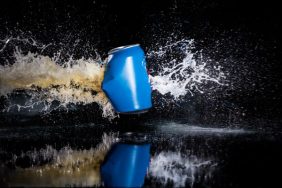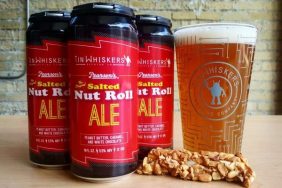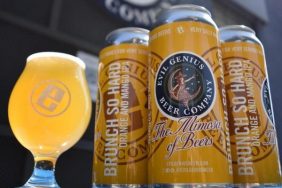New Year’s Eve is a time to both look forward and look back. We spend time looking back at the year that just ended while looking forward to the New Year that will soon be starting. We fondly reminisce about all the good times we had in the year that was while looking towards the New Year and its un-ending possibilities.
New Year’s Eve is also a time for resolutions. Everyone has something in their life that they wish they could change and the New Year is the perfect time to make that change. Whether you are hoping to get a new job, get in better shape, quit smoking or find love, we all have hope for a positive change in the New Year.
While New Year’s Eve is a time for thinking back on the year that was and looking forward to the year that will be, it’s also a time to celebrate the changing of the calendar to a new year. Some years seem more important than others (2000), but every year deserves to be celebrated.
Normally, we toast to a New Year with champagne or some other (cheaper) sparkling wine. But, during a time of year when we think about changes, why not change your choice of beverage?
Toast With a Sour Beer Instead
Forego the usual champagne and imbibe a sour beer instead. What is a sour beer, you say? The definition of a sour beer is really quite simple. It’s a beer that has a tart and sour flavor. The most popular varieties of sour beers are lambics, gauze and Flanders red ale.
One of the earliest forms of beer, the sour beer is a throw back to the way that all beer once was. There was a time (believe it or not) when you couldn’t pop into your neighborhood beer store and grab some yeast. People used to only be able to make beer if they used wild yeasts and bacteria that were then transferred from batch to batch. They didn’t have the sterile environments of today and the wild yeasts and bacteria were extremely important to the overall flavor of the beer.
Sour beers are made using wild yeasts and bacteria in the brewing process. Traditional Belgian brewers would brew their beer without any cover to allow the natural yeast and bacteria of the area to join the process. The reason this style of brewing is less common is because of how difficult it is to guarantee that every batch will taste the same as the batch before. Lactobacillus, Brettanomyces, and Pediococcus are the yeasts that are most commonly used to create sour beers. With the addition of these agents, the beer will take on acidity, thereby creating the sour, tart flavor we expect from a sour beer. Some sour beer makers also add fruits to the process to add to the flavor and tartness of the brew. Sour beers are generally aged in barrels to allow the flavors to grow over time. It takes a lot longer to make a sour ale than most other beer styles.
La Folie (New Belgium Brewing Company)

New Belgium’s La Folie, from their Lips Of Faith Series, is a wood-aged sour brown ale. The beer spends between one and three years in large oak casks to create a beer that contains the perfect mix of tart, sweetness, sour and acidity. In French, Folie means “The folly”. The name is a reference to the fact that your brain will be deceived by the intense flavors of crisp green apples and tart cherries. At 7% ABV, this Flanders Oud Bruin isn’t as high in alcohol as it is in taste.
Dissident (Deschutes Brewery)

At 11.1% ABV, Dissident should be given the respect it deserves. Almost as high in alcohol as a champagne, Dissident is the perfect replacement for a bottle of bubbly. With Pilsner, Munich, Bohemian Pilsner, Crystal 20, Dark Crystal (not to be confused with the movie) and Acidulated Malts as well as Czech Saas, Hallertauer Hersbrucker and Hallertauer Hallertauer hops, this Flanders Oud Bruin was barrel-aged from 18 months in pinot and cabernet casks to create a sour, tangy, tart beer. The addition of locally grown cherries adds a tart, sweetness to the beer.
Consecration (Russian River)

Aged in Cabernet Sauvignon casks for 4 to 8 months, Consecration sits at a potent 10% ABV. The addition of black currents adds a subtle sweet, tart flavor to this American wild ale. This beer is definitely not for sour beer novices. The high sour flavor might scare some away, but those who make the choice to drink a Consecration will be pleasantly surprised. You’ll be treated to the complex flavors of red wine, oak and dark fruits.
Westbrook Gose (Westbrook Brewing Company)

This offering from Westbrook is slightly different from the others on this list. At 4% ABV, this gose falls under the category of a session beer. That means that you shouldn’t have any fear of enjoying a few of these on New Years Eve. This tradition German-style sour wheat beer is made with coriander and salt. First released in 2012, this beer is guaranteed to make you pucker from its tart, dry flavors of sour, white grapes. Your mouth will be watering for more to savor after finishing a pint of this unique sour beer.
New Glarus Raspberry Tart (New Glarus Brewing Company)

Another low-ABV beer, New Glarus Raspberry Tart is a 4% taste experience and might be the perfect alternative to champagne. High in tart, raspberry flavor this beer is best served cold in a champagne flute. Listed as a Wisconsin framboise ale, Raspberry Tart is perfectly paired with holiday favorites like cheesecake, caramel and chocolate fudge brownies. Definitely pick up some of this unique beer to ring in the New Year.








